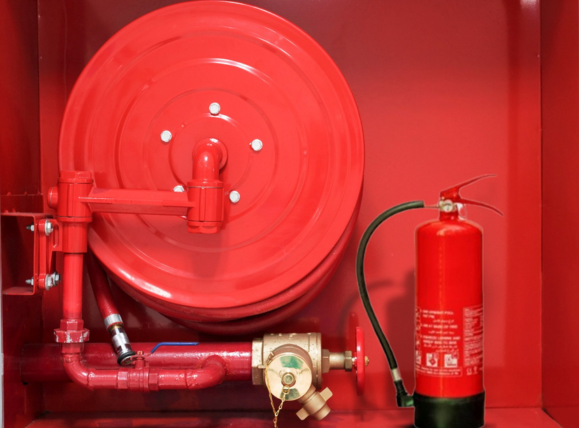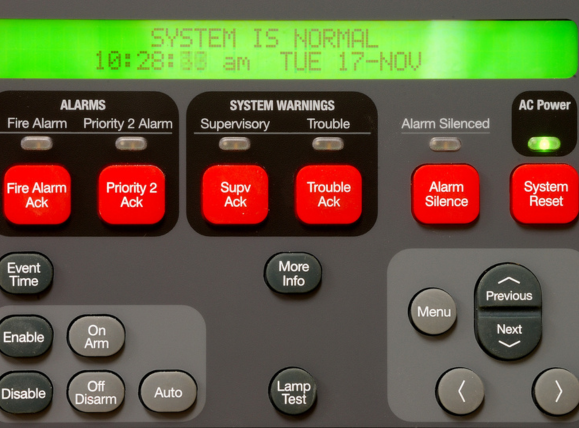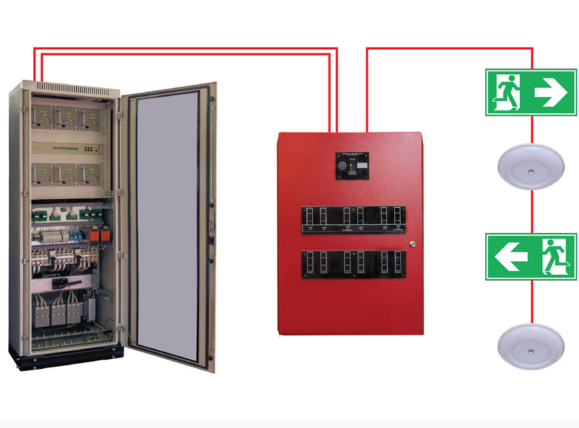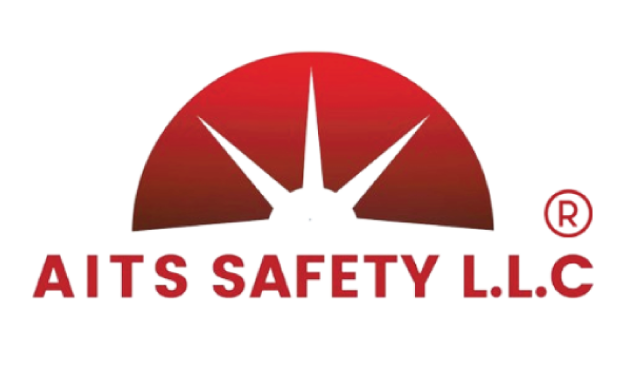Explore Our Comprehensive Range of Services
DCD Approved Fire Fighting Company in Dubai
As a leading DCD Approved fire fighting company in Dubai, we pride ourselves on offering a comprehensive range of cutting-edge fire safety equipments and services designed to safeguard lives and property. Our expertise includes advanced Fire Alarm Systems for early detection of fire-related emergencies, along with Voice Evacuation Systems to ensure clear communication during critical situations. We provide reliable Emergency Exit Lighting Systems to guide safe evacuations, and a full array of fire safety equipments and fire suppression solutions, including Fire Extinguishers, Fire Hose Reels, and Water-Based Sprinkler Systems. Our Fire Hydrant Systems and powerful Fire Pumps ensure fast and effective fire suppression when needed most. For specialized fire risks, we offer state-of-the-art FM200 Suppression Systems, Foam Deluge Systems, and Water Mist Suppression Systems. We also specialize in Addressable Fire Alarm Systems for precise detection and Central Battery Emergency Exit Lighting Systems for uninterrupted safety. With our extensive range of fire protection solutions and fire safety equipments, we are committed to providing unparalleled safety and peace of mind for businesses, homes, and public spaces across Dubai. Trust us to deliver top-tier fire safety services that meet the highest standards of reliability and efficiency.

FIRE ALARM SYSTEM
Fire alarm systems are indispensable for ensuring building safety, detecting various fire-related emergencies like fires, smoke, and carbon monoxide swiftly. Once triggered, these systems promptly alert occupants and emergency responders, facilitating quick and appropriate action to mitigate risks and protect lives and property. Our company, the leading fire alarm systems provider in Dubai, prioritizes ethical solutions aimed at enhancing client safety and property security. With a comprehensive range of cutting-edge systems from top industry brands like EST, Honeywell, and Siemens, we ensure our clients have access to reliable and advanced technology. Whether it’s addressable or conventional systems, wireless solutions, our expertise lies in designing, installing, and maintaining tailored solutions to meet specific needs, ensuring optimal safety standards.
VOICE EVACUATION SYSTEM
Voice evacuation and fireman telephone systems are vital for effective communication during emergencies in Dubai. They provide a standardized channel for occupants and responders, ensuring swift and accurate information exchange. Even during power outages, these systems maintain uninterrupted communication. With pre-recorded messages or live announcements, they offer clear instructions to minimize confusion and panic during evacuations. Round-the-clock support ensures timely assistance. Brands like ATEIS, Bosch, Honeywell, Zeta, and Atena are commonly trusted for these critical systems, enhancing fire safety infrastructure and protecting lives and property.


EMERGENCY EXIT LIGHTING SYSTEM
Emergency lights play a critical role in enhancing the safety and security of building occupants during emergencies by providing directional guidance, illuminating exit routes, highlighting firefighting equipment, and ensuring compliance with safety regulations. Their presence can significantly improve the effectiveness of emergency response efforts and minimize the risk of injuries or fatalities. The battery system is indeed a critical component of emergency lighting, providing power to illuminate exit routes and critical areas during power outages or emergencies. The main types of emergency exit light systems are Self-Contained Emergency Exit light system, Central Monitoring System and Central Battery system. The most common brands used are Eaton, Guard max, Frontier, Gessler, Mega light, Dali, Eaton, JSB, Ceag, Emergi-lite, EML, TM Technology, Easi check, Teknoware, Clever light, Awex, Olympia, Secure and Inotec.
FIRE EXTINGUISHER
A fire extinguisher is a vital piece of fire safety equipment designed for use in combating small fires. These handheld devices typically contain either dry chemical or wet chemical agents that are discharged onto a fire to extinguish or control it. Fire extinguishers are classified based on the types of fires they are effective against. Fire extinguishers are classified based on the types of fires they are effective against. Common classifications include Class A (ordinary combustibles like wood or paper), Class B (flammable liquids), Class C (electrical fires), Class D (flammable metals), and Class K (cooking oils or fats). Regular maintenance, inspection, and training in the proper use of fire extinguishers are essential aspects of fire safety practices to ensure they remain effective in emergencies. The main common types of extinguishers are CO2, Dry Chemical Powder, Foam, Water, Automatic Dry Powder, Wet chemical etc. The most common brands used are Naffco, Bristol, Wetplug, Fire Guard, Frontier, Firex, Flametech, Eversafe


FIRE HOSEREEL
Fire Hose reels are essential components of fire safety systems, particularly in larger or high-risk environments like schools, hotels, factories, and other commercial or industrial settings. These reels typically consist of a length of hose wound around a spindle, mounted on a wall and connected to a water supply. Fire hose reels are an integral part of a comprehensive fire safety plan, providing an important means of fire suppression in larger or high-risk environments. Its major components are Nozzle, Hose, Arm, Drum etc. Most common types of Hose reel are Cabinet Mounted Hose reel, Swinging Hose reel, Fixed Hose reel, Recessed mounted, Automatic Hose reel, Manual Hose reel, High pressure and Low-pressure Hose reel.The common brands used are Naffco, Bristol, Eversafe, Walker
WATER BASED SPRINKLER SYSTEM
A fire sprinkler system is an active fire protection method that suppresses or extinguishes fires in buildings. It relies on a water supply, often connected to the building’s municipal water line or a dedicated water tank, to provide sufficient pressure and flow rate. Pipes distribute water throughout the building to sprinkler heads, strategically placed on ceilings or walls. These heads contain heat-sensitive elements, like glass bulbs or fusible links. When a fire’s heat triggers them, specific sprinkler heads release water to cool the fire and prevent its spread. This activation often triggers alarms to alert occupants and responders. Sprinkler systems, mandated by building codes, come in various types (Pendant, Upright, Concealed, etc.) and are manufactured by brands like Tyco, Naffco, Shield, and Rapidrop, ensuring crucial fire safety measures.


FIRE HYDRANT SYSTEM
Fire hydrant systems are indeed vital for distributing water across different areas, ensuring that firefighting efforts can be conducted effectively and efficiently. These systems consist of various components working together to ensure proper water distribution to critical areas, enabling swift extinguishing measures to be taken. Fire hydrant systems play a significant role in protecting the environment from fire hazards, helping to minimize damage and preserve natural resources. the comprehensive coverage and efficient operation of fire hydrant systems make them indispensable components of fire protection infrastructure, particularly in urban areas like Dubai. Their ability to provide reliable water distribution for firefighting efforts contributes significantly to safeguarding lives, property, and the environment from the devastating effects of fires. Two types of fire hydrants are Dry Barrel type and the Wet Barrel type.
FIRE PUMP
Fire pump systems are crucial for efficiently controlling fires and offering effective solutions during fire emergencies. They ensure water supply from various sources, contributing to comprehensive fire containment. Pumps are essential for maintaining adequate water pressure in fixed-place fire suppression systems like fire sprinklers, standpipes (used in high-rise buildings for firefighting), and foam systems. These systems rely on water pressure to effectively extinguish or control fires. Fire pumps are designed to be robust and reliable, capable of operating under high-pressure conditions to support firefighting efforts in various scenarios. Centrifugal pumps are the most common fire pumps and are used with most systems. With centrifugal pumps, pressure is developed principally by the action of centrifugal force or spinning. Horizontal split case & Vertical split case are the common types of pumps. Jockey, Electrical and Diesel pumps are the main three types of Fire pump. When a fire pump is both “UL Listed” and “FM Approved,” it indicates that the pump has undergone testing and evaluation by both UL (Underwriters Laboratories) and FM Global (formerly Factory Mutual) and has met the respective organizations’ standards for safety, performance, and reliability. The common brands used are Naffco, Fire driver, Waterfall, SFFECO, Bristol, Tornatech


FM200 SUPPRESSION SYSTEM
FM-200 is a clean agent fire suppressant effective against Class A, B, and C fires. It’s colorless, non-toxic, and leaves no residue, making it ideal for safeguarding high-value assets. FM-200 cylinders store this gas, widely used across industries, particularly where residue cleanup is an issue. Common in places like bank vaults, data centers, and museums, FM-200 offers reliable fire protection without damaging sensitive equipment. Other popular suppression systems include NOVEC 1230 and ANSUL INERGEN.
FOAM DELUGE SYSTEM
Foam deluge systems are commonly used in areas where water suppression alone may not be effective or safe, such as around transformers, oil tanks, or areas with flammable liquids. These systems utilize a mixture of water and foam concentrate, which, when discharged, creates a foam blanket over the fire, smothering it and suppressing the flames. Similar to other fire suppression systems, the foam deluge system is equipped with detectors or sensors that monitor for signs of fire. Once a fire is detected, the system activates. Foam deluge systems are effective in extinguishing fires involving flammable liquids or in areas where water alone may not be sufficient. Cleaning up the foam residue after a fire event can be time-consuming and may require specialized equipment and materials. However, the effectiveness of foam deluge systems in preventing catastrophic fires often outweighs the inconvenience of cleanup.


FIRE SUPPRESSION SYSTEM
Fire suppression systems are diverse in their applications, with various types designed to extinguish, control, or prevent fires in different settings. These systems are crucial for protecting lives and property from the devastating effects of fires. While many modern fire suppression systems adhere to updated regulations and safety standards, there are some older systems that may still be in use but are no longer legal to manufacture or produce due to safety concerns or advancements in technology. The various types of fire suppression are Clean agent system, Chemical agent system, Inert gas system, CO2 System, Water based system. The common brands used are Fike, Notifier, Siemens, Nitie.
AEROSOL SUPPRESSION SYSTEM
Aerosol fire suppression system is a relatively newer innovation in fire suppression technology. This system operates by releasing condensed aerosol particles into the protected space to extinguish or control a fire. It’s increasingly being utilized in various applications, including control panels, battery packs, new energy storage facilities, cabinets, vehicle compartments, and other small enclosed spaces. These systems are compact and can be easily installed in small enclosed spaces, making them suitable for various applications where traditional fire suppression systems may not be feasible. Condensed aerosol fire suppression systems represent a modern and efficient approach to fire protection, particularly in applications where space constraints or rapid response times are critical factors.


WATER MIST SUPPRESSION SYSTEM
Water mist systems are indeed fire suppression systems that utilize very fine water droplets to extinguish or control fires. These systems offer several advantages over traditional sprinkler systems. water mist systems often require higher operating pressures compared to traditional sprinkler systems, which may increase installation costs and maintenance requirements. It offers a versatile and effective solution for a wide range of applications, and understanding the basics of these systems can help expand options in fire protection design portfolios.
ADDRESSABLE FIRE ALARM SYSTEM
Addressable systems provide detailed information about the exact location of a fire or fault. Each device on the system has a unique address, allowing the control panel to pinpoint the precise location of any activated detector or call point. This enables quicker response times and reduces the likelihood of false alarms.
As an esteemed organization specializing in fire alarm systems, we pride ourselves on offering the highest quality products and services.


CENTRAL BATTERY EMERGENCY EXIT LIGHTING SYSTEM
Central Battery Systems (CBS) for emergency lighting offer a centralized backup power solution, utilizing a single battery bank or power source to supply multiple emergency lights and exit signs throughout a building or facility. Unlike individual setups, where each light has its own power source, CBS connects all fixtures to a central system installed in a designated area like a mechanical or electrical room. Through a wired distribution network, the central battery system ensures simultaneous backup power provision to all connected fixtures during power outages or emergencies. This setup guarantees consistent illumination in critical areas such as exit routes, stairwells, and corridors, guiding occupants to safety. CBS not only provides reliability but also efficiency by centralizing the power source, thus reducing energy consumption and maintenance costs compared to individual battery setups. Popular brands include CEAG, Awex, Eaton, and Teknoware.
CENTRAL MONITORING EMERGENCY EXIT LIGHTING SYSTEM
Central monitoring systems for emergency lighting indeed offer several benefits in terms of system oversight and management. A central monitoring system is capable of overseeing all individual components of an emergency lighting system, including luminaires, batteries, and control units. This ensures that any issues or malfunctions can be quickly identified and addressed. The system gathers data from all monitored components and consolidates it into a single location or dashboard. This centralized approach makes it easy for facility managers or maintenance personnel to access and review system status and performance. central monitoring systems play a crucial role in ensuring the reliability and effectiveness of emergency lighting systems. By providing real-time oversight, data recording, and customizable management features, these systems help maintain compliance, minimize downtime, and enhance overall safety in buildings and facilities.


CONVENTIONAL FIRE ALARM SYSTEM
Conventional Fire Alarm systems divide the protected area into zones, with detectors and call points wired to specific zones. When activated, the system identifies the zone in which the alarm was triggered but doesn’t provide specific information about the exact location of the fire. This zoning approach can lead to delays in emergency response, as responders may need to search multiple areas within the activated zone to locate the source of the fire. In large buildings or complexes with numerous zones, this process can be time-consuming and potentially hazardous.
KITCHENHOOD SUPPRESSION SYSTEM
Kitchen Hood suppression systems are specifically designed to protect commercial kitchens from fire hazards, particularly those involving cooking equipment and grease buildup. These systems are typically installed above cooking appliances and under the ventilation hoods to quickly detect and suppress fires before they can spread. Kitchen hood suppression systems are essential safety measures in commercial kitchens where the risk of grease fires is high. Their rapid response and effective suppression capabilities help protect both property and personnel, minimizing the potential for fire-related damage and injuries. Regular maintenance and inspection of these systems are crucial to ensure their continued reliability and effectiveness in emergency situations.


SELF CONTAINED EMERGENCY EXIT LIGHTING SYSTEM
Self-contained emergency lighting systems operate by being connected to the normal mains power during regular operation. However, in the event of a power outage or emergency, these luminaires seamlessly switch over to an internal battery power source, ensuring continued illumination of exit routes and critical areas. The battery backup power allows the emergency lighting to continue operating for a specified duration, typically for the duration of the emergency or until mains power is restored. This ensures that exit routes remain illuminated and occupants can safely evacuate the building. Self-contained emergency lighting systems offer several advantages, including ease of installation, flexibility in placement, and reliability in providing illumination during emergencies. They are commonly used in various indoor and outdoor applications, including commercial buildings, industrial facilities, schools, and healthcare facilities, to ensure compliance with safety regulations and provide peace of mind for building occupants.
WIRELESS FIRE ALARM SYSTEM
The Wireless Fire Alarm Control Panel is a specialized system designed for fire security, management, and control of fire alarm devices without the need for traditional wired connections. Its use of radio communication between the control panel and the fire detectors makes it ideal for installations where laying cables is impractical or undesirable, such as historic buildings, temporary structures, or locations where extensive wiring is not feasible. The system utilizes wireless technology for communication between the control panel and fire detectors, eliminating the need for extensive cabling infrastructure. The system can be easily expanded or reconfigured as needed by adding or relocating wireless detectors, offering scalability to accommodate changes in the layout or requirements of the premises.

Compassion
Commitment
Excellence
Team Work
Value
Ethnicity

WE'RE QUALIFIED & PROFESSIONAL
We believe in the following core values
We're Qualified dolor sit amet, consectetur adipiscing elit, sed do eius tempor incididunt ut labore et dolore magna aliqua. Ut enim adiqua minim veniam quis nostrud exercitation ullamco laboris sed

-
Security Consulting
-
Private Security
-
Close Protections
-
Guard House
-
Always Honest
-
24/7 Constant Support
LOVES FROM SPECIAL CLIENTS
Loves From Special Clients consec tetur adipiscing elit, sed do eius incididunt ut labore et
Morgaan Smith is effectively a review or recommendation from a client, letting other people know how your products or services benefitted them. Customer testimonials can take.

Morgaan Smith
Will Jacson is effectively a review or recommendation from a client, letting other people know how your products or services benefitted them. Customer testimonials can take.

Will Jacson
Adam Smith is effectively a review or recommendation from a client, letting other people know how your products or services benefitted them. Customer testimonials can take.

Adam Smith
Hill Peter is imonial effectively a review or recommendation from a client, letting other people know how your products or services benefitted them. Customer testimonials can take.



